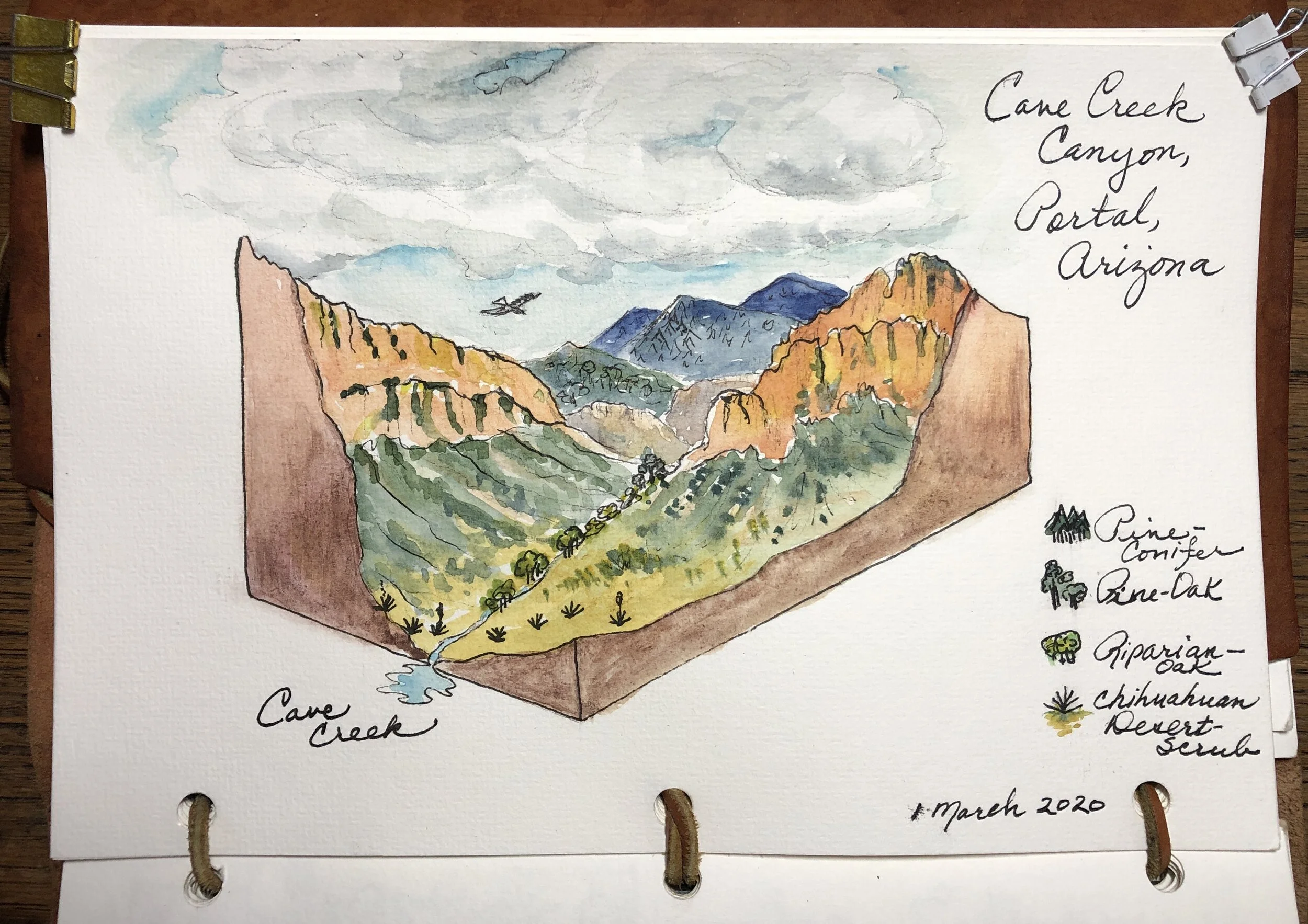I love field arts—writing in a field notebook (ie: nature journaling), sketching, painting, and drawing maps. Cartography might be one of my favorite, partly because it is one of the oldest field arts—some ancient petroglyphs might actually be maps (there are several at Twyfelfontein in Namibia)—and because maps are just geeky-cool. I love that maps are a combination of the three primary ways to record nature data: written, visual, and numerical.
Here I share a step-by-step pictorial on how to render a cool 3D map. I created this “map” from a photo after a visit to Cave Creek in Arizona's Chiricahua Mountains, in the far southeast corner of that U.S. state.
The biggest challenge for doing a 3D map of a landscape is pulling the "box" out of the 2D image and envisioning the "cut away" part in a way that works in a 3D cube or rectangle. John Muir Laws has an excellent tutorial on how to create a 3D map in his excellent Laws Guide to Nature Drawing and Journaling. He recommends practicing on invented landscapes; I’m taking it the next step and showing how I created 3D cube maps from actual landscapes.
Step 1: Study your photo or live landscape and decide where you want to pull out your 3D box. I wanted to be sure to depict the creek, especially the whimsical spillage off the box (idea stolen from John Laws). Getting the landscape right in the box is the hardest part, and you will probably have to do 4 or 5 tries before it feels right. That's how many it took me on this one! I used this photo for inspiration; from the Friends of Cave Creek Canyon (FOCCC) on Facebook, by Steve Wolfe.
Step 2: After studying your photo (or live landscape) and deciding where to pull out your 3D box, use a pencil to draw a square or rectangle on your page (any shape you like, it’s up to you), with all the corners and "bottom" included. Using pencil still, sketch in the upper corners and limits of the landscape within the box. You can see I drew the right-most upper corner too high and fixed it later. Then I added the general creek location and the background.
Step 3: When I was happy with the placement of the landscape elements, I drew over the main parts in pen, using waterproof ink.
Step 4: After the pen dries, carefully erase the pencil lines that marked the structure of the box. Then go back with pencil and add details; I roughed in the rock spires, the slopes, where I wanted to make the darker patches of vegetation, and a few symbols for habitat types. When happy, I finalized in loose pen sketching, keeping the marks fairly light.
Step 5: The final step was adding the watercolor, making sure to make the farthest mountains darker and warmer blue in tone so they feel like they are receding (instead of making them green or cooler blue). Don't go crazy on the details for something this size and this simple.
I decided to add the clouds and hawk as a fun whimsy.
The next four images show another landscape I sketched, my work place at the University of Arizona’s Desert Laboratory on Tumamoc Hill, just west of downtown Tucson. For tutorial purposes, I drew a red rectangle in Photoshop over the image to show where I wanted to capture my 3D map. The placement was specific because I wanted to 1) have enough elevation at the back of the cube to fill it up; and 2) I wanted to encompass the sandy “wash” (dry creek) that runs at the base of the hill, because I’m slightly obsessed with the fun of creeks spilling off the cubes (in this case, dry sand . . .). Note that I also sketched in tree roots, that I wanted to show the dark volcanic underground, and that I added a vulture soaring over the northeast side, and added its shadow to help add a sense of space and fun.
The main thing here is to have fun, and keep trying—these are not easy, but they are great practice at visualizing landscapes in new ways. You really have to study a place, including having “x-ray” vision to see below the surface.












